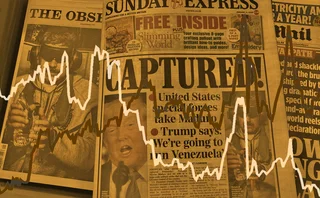
Monoline bailout looking likely
As market conditions continue to deteriorate, interested parties are coming together in an attempt to save the imperilled US monoline insurers from bankruptcy.
The talks follow the release on January 22 of a proposed rescue plan by the New York State Insurance Department (NYSID) to improve the capital positions of monolines, protect policyholders and ensure the continued availability of bond insurance.
Since December, several monolines – including Ambac, MBIA, CIFG, FGIC and SCA Capital – have come under severe pressure to avoid ratings downgrades, culminating in Ambac losing its triple-A rating from Fitch on January 18.
Fears that this action could trigger a further wave of downgrades - and heavy losses to dealers and investors exposed to monolines - prompted several calls for a co-ordinated market response to the problem. And, although some observers might think the talks held this week came too late, the market reacted as if a bailout for the affected insurers is imminent.
Five-year credit default swaps for Ambac and MBIA, both north of 700 basis points on Monday, were respectively trading at 455bp and 400bp on Thursday, reflecting a degree of restored confidence in the sector.
Precise details on the talks, specifically how the monolines can boost capital and avert ratings, have not emerged – NYSID declined to talk to Risk yesterday – but various analysts viewed a bailout as the only available solution.
“The costs for a bailout compared with the consequences of not doing anything are very favourable for the government and regulators,” said Jochen Felsenheimer, head of credit strategy and structured credit research at Unicredit. “Ultimately this is not the final solution – it is more a case of fighting the symptoms. So it will not help limit any impact on the real economy but it helps to restore confidence in credit derivatives and the structured credit market.”
Alexander Batchvarov, head of international structured finance research at Merrill Lynch, argued guarantors should be supported in their hour of need in return for the support they have given the financial markets over several years. Even so, he said stabilizing the financial position would not by itself restore investor confidence.
“The main concern investors still have is the possibility of another firesale of assets, which will widen spreads further and erode the value of their investments,” said Batchvarov. “Only when the market believes the threat of firesales has diminished will we start seeing a restoration of investor appetite and, beyond that, new issuance.”
One ominous dimension of NYSID’s proposal was its intention to develop stronger regulation for bond insurance. “Since it is clearly time to develop new rules for the road, the department is drafting new regulations that would redefine the future activities of bond insurers,” stated NYSID in a press release.
As to whether this means insurers will be encouraged to avoid risky structured credit products, Batchvarov believes all players active in the market will be risk averse in the short term.
“This will show itself through a dramatic repricing of risk and the unwinding of excess leverage seen in recent years. But I would imagine, going forward, risks surrounding mark-to-market losses and liquidity issues will be factored more vigorously into the monolines’ underwriting standards,” concluded Batchvarov.
See also: Clock ticking for troubled monolines
S&P puts pressure on monolines
Only users who have a paid subscription or are part of a corporate subscription are able to print or copy content.
To access these options, along with all other subscription benefits, please contact info@risk.net or view our subscription options here: http://subscriptions.risk.net/subscribe
You are currently unable to print this content. Please contact info@risk.net to find out more.
You are currently unable to copy this content. Please contact info@risk.net to find out more.
Copyright Infopro Digital Limited. All rights reserved.
As outlined in our terms and conditions, https://www.infopro-digital.com/terms-and-conditions/subscriptions/ (point 2.4), printing is limited to a single copy.
If you would like to purchase additional rights please email info@risk.net
Copyright Infopro Digital Limited. All rights reserved.
You may share this content using our article tools. As outlined in our terms and conditions, https://www.infopro-digital.com/terms-and-conditions/subscriptions/ (clause 2.4), an Authorised User may only make one copy of the materials for their own personal use. You must also comply with the restrictions in clause 2.5.
If you would like to purchase additional rights please email info@risk.net
More on Markets
Brokers must shift HFT servers after China colocation ban
New exchange guidance drives rush for “proximity colo” in nearby data centres
LatAm FX carry trade shrugs off geopolitical fears
Clients in regional carry positions remain undeterred by US interventions, say dealers
S&P bull run drives interest in reset and lookback hedges
Variable strike put options proved popular alternative hedging format of 2025
US mutual funds slash short euro positions at record pace
Counterparty Radar: Pimco cut $4.6bn of EUR/USD puts in Q3 amid changing stance on dollar direction
Nomura hires new global eFX head
Mark McMillan to oversee e-trading and sales activities in newly created role
Trump’s LatAm gambit spurs FX hedging rush
Venezuela op boosts risk reversals as investors look to protect carry trades
One Trading brings 24/7 equity trading to Europe
Start-up exchange will launch perpetual futures Clob in Q1 after AFM nod
FXGO volumes surge despite fee switch-on
Dealers split on whether levy is behind volume increases across SDPs







